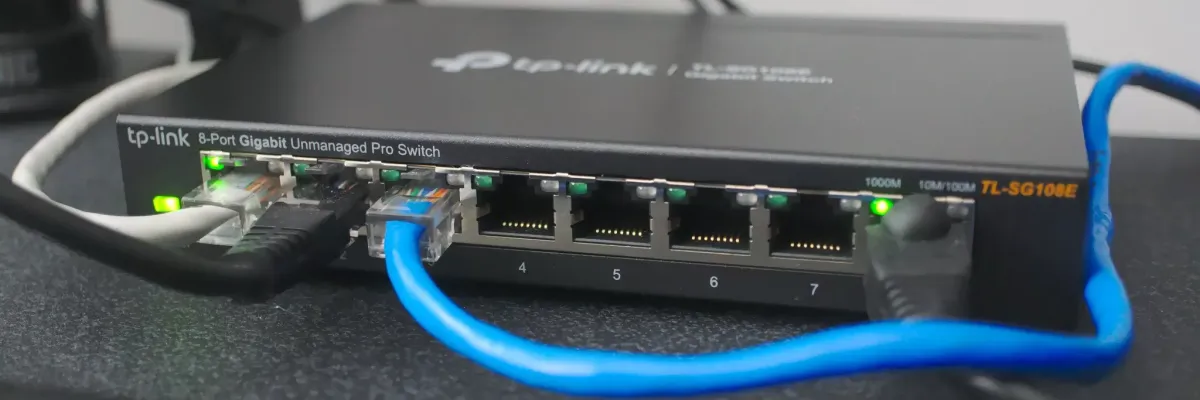
What is an Unmanaged Switch?
An unmanaged switch is a type of network switch that does not have the ability to be configured or managed by an administrator. It is a plug-and-play device that simply forwards network traffic from one device to another without any intervention or control from the user.
Unmanaged switches are typically used in smaller networks where there is no need for advanced features such as VLANs or Quality of Service (QoS) prioritization. They are also typically less expensive than managed switches and require less maintenance, making them a popular choice for home networks and small businesses with simple network needs. However, they offer limited control and visibility over network traffic and cannot be optimized for specific applications or workloads.
Comparing Unmanaged and Managed Switches
Unmanaged and managed switches are both used in computer networking, but they differ in their functionality, complexity, and cost. Here are some of the key differences between unmanaged and managed switches:
Functionality:
Unmanaged switches are simply plug-and-play devices that can forward network traffic from one device to another without any intervention or control from the user. Managed switches, on the other hand, can be configured and managed by an administrator, allowing for the monitoring and control of network traffic, VLANs, QoS, and other advanced features.
Complexity:
Unmanaged switches are relatively simple and do not require any special skills or knowledge to use. Managed switches, on the other hand, are more complex and need technical expertise to set up, configure, and manage.
Cost:
Unmanaged switches are generally less expensive than managed switches, making them a popular choice for home networks and small businesses with simple network needs. Managed switches are more expensive due to their advanced features and the technical expertise required to configure and manage them.
Scalability:
Unmanaged switches are typically limited in scalability, as they cannot be configured to support large networks or complex network topologies. Managed switches, on the other hand, can be configured to support large networks with multiple VLANs, QoS policies, and other advanced features.
In summary, unmanaged switches are simple, inexpensive, and easy to use, but they offer limited control and visibility over network traffic. Managed switches are more complex and expensive, but they offer advanced features and the ability to configure and manage network traffic, making them a better choice for larger networks or networks with specific requirements.
Unmanaged Industrial Grade Switches
| Model | Product Name | Copper Ports | Copper Speed | Fiber Ports | Fiber Speed | Connector Type |
| SF70460 | 4-Port Unmanaged Industrial Switch | 2 | 10/100/1000 | 2 | 100/1G | LC |
| SF70660 | 6-Port Unmanaged Industrial Switch | 6 | 10/100/1000 | 2 | 100/1G | LC |
| SF70760 | 7-Port Unmanaged Industrial Switch | 4 | 10/100/1000 | 1 | 100/1G | LC |
| SF70960 | 9-Port Unmanaged Industrial Switch | 8 | 10/100/1000 | 1 | 100/1G | LC |
| SF71060 | 10-Port Unmanaged Industrial Switch | 8 | 10/100/1000 | 2 | 100/1G | LC |
How to Choose Between Managed and Unmanaged Network Switches
Choosing between a managed and unmanaged switch depends on several factors such as the size of your network, the complexity of your network infrastructure, the level of control and visibility you require, and your budget.
Size of Network:
If you have a small network with only a few devices, an unmanaged switch may be sufficient. However, if you have a large network with multiple devices and users, a managed switch is necessary to control traffic and improve network performance.
Network Infrastructure:
If your network has a simple topology, an unmanaged switch may suffice. However, if you have a complex network infrastructure with multiple VLANs, QoS policies, and security requirements, a managed switch is the better option.
Level of Control and Visibility:
If you need more control over your network traffic, such as the ability to prioritize certain types of traffic or limit bandwidth usage, a managed switch is necessary. Unmanaged switches offer limited control and visibility over network traffic.
Budget:
Unmanaged switches are generally less expensive than managed switches. If your budget is limited, an unmanaged switch may be a good option. However, if you require advanced features and greater control over your network, a managed switch may be worth the investment.
In summary, if you have a small, simple network with limited traffic control needs and a tight budget, an unmanaged switch may be suitable. However, if you have a large, complex network with advanced traffic control requirements and a need for greater control and visibility, a managed switch is likely necessary.
Conclusion
In conclusion, managed and unmanaged switches differ in functionality, configuration, complexity, scalability, and cost. Managed switches are more advanced, configurable, and scalable, but they require technical expertise and are more expensive. Unmanaged switches, on the other hand, are simpler, more affordable, and easier to use, but they offer limited functionality and scalability. When choosing between managed and unmanaged switches, it is important to consider the size and complexity of your network, your control and visibility needs, and your budget. Ultimately, the choice will depend on your specific requirements and network environment.
